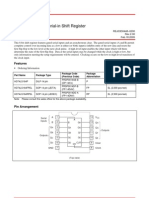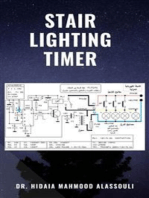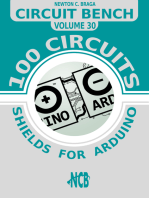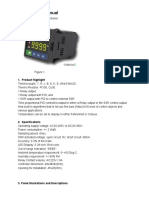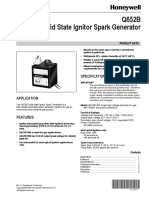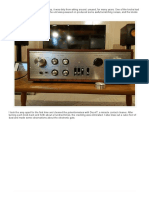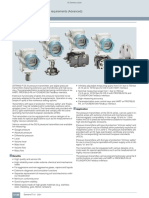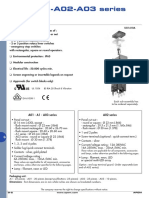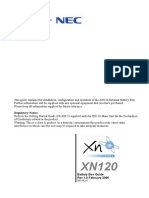DM74LS164 8-Bit Serial In/Parallel Out Shift Register: General Description Features
DM74LS164 8-Bit Serial In/Parallel Out Shift Register: General Description Features
Uploaded by
Roby Adi WibowoCopyright:
Available Formats
DM74LS164 8-Bit Serial In/Parallel Out Shift Register: General Description Features
DM74LS164 8-Bit Serial In/Parallel Out Shift Register: General Description Features
Uploaded by
Roby Adi WibowoOriginal Title
Copyright
Available Formats
Share this document
Did you find this document useful?
Is this content inappropriate?
Copyright:
Available Formats
DM74LS164 8-Bit Serial In/Parallel Out Shift Register: General Description Features
DM74LS164 8-Bit Serial In/Parallel Out Shift Register: General Description Features
Uploaded by
Roby Adi WibowoCopyright:
Available Formats
DM74LS164 8-Bit Serial In/Parallel Out Shift Register
August 1986 Revised April 2000
DM74LS164 8-Bit Serial In/Parallel Out Shift Register
General Description
These 8-bit shift registers feature gated serial inputs and an asynchronous clear. A low logic level at either input inhibits entry of the new data, and resets the first flip-flop to the low level at the next clock pulse, thus providing complete control over incoming data. A high logic level on either input enables the other input, which will then determine the state of the first flip-flop. Data at the serial inputs may be changed while the clock is HIGH or LOW, but only information meeting the setup and hold time requirements will be entered. Clocking occurs on the LOW-to-HIGH level transition of the clock input. All inputs are diode-clamped to minimize transmission-line effects.
Features
s Gated (enable/disable) serial inputs s Fully buffered clock and serial inputs s Asynchronous clear s Typical clock frequency 36 MHz s Typical power dissipation 80 mW
Ordering Code:
Order Number DM74LS164M DM74LS164N Package Number M14A N14A Package Description 14-Lead Small Outline Integrated Circuit (SOIC), JEDEC MS-120, 0.150 Narrow 14-Lead Plastic Dual-In-Line Package (PDIP), JEDEC MS-001, 0.300 Wide
Devices also available in Tape and Reel. Specify by appending the suffix letter X to the ordering code.
Connection Diagram
Function Table
Inputs Clear L H H H H Clock X L A X X H L X B X X H X L QA L QA0 H L L Outputs QB L QB0 QAn QAn QAn ... ... ... ... ... ... QH L QH0 QGn QGn QGn
H = HIGH Level (steady state) L = LOW Level (steady state) X = Don't Care (any input, including transitions) = Transition from LOW-to-HIGH level QA0, QB0, QH0 = The level of QA, QB, or QH, respectively, before the indicated steady-state input conditions were established. QAn, QGn = The level of QA or QG before the most recent transition of the clock; indicates a one-bit shift.
2000 Fairchild Semiconductor Corporation
DS006398
www.fairchildsemi.com
DM74LS164
Logic Diagram
Timing Diagram
www.fairchildsemi.com
DM74LS164
Absolute Maximum Ratings(Note 1)
Supply Voltage Input Voltage Operating Free Air Temperature Range Storage Temperature Range 7V 7V 0C to +70C 65C to +150C
Note 1: The Absolute Maximum Ratings are those values beyond which the safety of the device cannot be guaranteed. The device should not be operated at these limits. The parametric values defined in the Electrical Characteristics tables are not guaranteed at the absolute maximum ratings. The Recommended Operating Conditions tables will define the conditions for actual device operation.
Recommended Operating Conditions
Symbol VCC VIH VIL IOH IOL fCLK tW tSU tH tREL TA Supply Voltage HIGH Level Input Voltage LOW Level Input Voltage HIGH Level Output Current LOW Level Output Current Clock Frequency (Note 2) Pulse Width (Note 2) Data Setup Time (Note 2) Data Hold Time (Note 2) Clear Release Time (Note 2) Free Air Operating Temperature Clock Clear 0 20 20 17 5 30 0 70 Parameter Min 4.75 2 0.8 0.4 8 25 Nom 5 Max 5.25 Units V V V mA mA MHz ns ns ns ns C
Note 2: TA = 25C and VCC = 5V.
Electrical Characteristics
over recommended operating free air temperature range (unless otherwise noted) Symbol VI VOH VOL Parameter Input Clamp Voltage HIGH Level Output Voltage LOW Level Output Voltage II IIH IIL IOS ICC Input Current @ Max Input Voltage HIGH Level Input Current LOW Level Input Current Short Circuit Output Current Supply Current Conditions VCC = Min, II = 18 mA VCC = Min, IOH = Max VIL = Max, VIH = Min VCC = Min, IOL = Max VIL = Max, VIH = Min IOL = 4 mA, VCC = Min VCC = Max, VI = 7V VCC = Max, VI = 2.7V VCC = Max, VI = 0.4V VCC = Max (Note 4) VCC = Max (Note 5) 20 16 2.7 3.4 0.35 0.25 0.5 0.4 0.1 20 0.4 100 27 mA A mA mA mA Min Typ (Note 3) Max 1.5 Units V V
Note 3: All typicals are at VCC = 5V, TA = 25C. Note 4: Not more than one output should be shorted at a time, and the duration should not exceed one second. Note 5: ICC is measured with all outputs OPEN, the SERIAL input grounded, the CLOCK input at 2.4V, and a momentary ground, then 4.5V, applied to the CLEAR input.
Switching Characteristics
at VCC = 5V and TA = 25C From (Input) Symbol fMAX tPLH tPHL tPHL Parameter Maximum Clock Frequency Propagation Delay Time LOW-to-HIGH Level Output Propagation Delay Time HIGH-to-LOW Level Output Propagation Delay Time HIGH-to-LOW Level Output Clock to Output Clock to Output Clear to Output To (Output) CL = 15 pF Min 25 27 32 36 30 40 45 Max RL = 2 k CL = 50 pF Min Max MHz ns ns ns Units
www.fairchildsemi.com
DM74LS164
Physical Dimensions inches (millimeters) unless otherwise noted
14-Lead Small Outline Integrated Circuit (SOIC), JEDEC MS-120, 0.150 Narrow Package Number M14A
www.fairchildsemi.com
DM74LS164 8-Bit Serial In/Parallel Out Shift Register
Physical Dimensions inches (millimeters) unless otherwise noted (Continued)
14-Lead Plastic Dual-In-Line Package (PDIP), JEDEC MS-001, 0.300 Wide Package Number N14A
Fairchild does not assume any responsibility for use of any circuitry described, no circuit patent licenses are implied and Fairchild reserves the right at any time without notice to change said circuitry and specifications. LIFE SUPPORT POLICY FAIRCHILDS PRODUCTS ARE NOT AUTHORIZED FOR USE AS CRITICAL COMPONENTS IN LIFE SUPPORT DEVICES OR SYSTEMS WITHOUT THE EXPRESS WRITTEN APPROVAL OF THE PRESIDENT OF FAIRCHILD SEMICONDUCTOR CORPORATION. As used herein: 1. Life support devices or systems are devices or systems which, (a) are intended for surgical implant into the body, or (b) support or sustain life, and (c) whose failure to perform when properly used in accordance with instructions for use provided in the labeling, can be reasonably expected to result in a significant injury to the user. 5 2. A critical component in any component of a life support device or system whose failure to perform can be reasonably expected to cause the failure of the life support device or system, or to affect its safety or effectiveness. www.fairchildsemi.com
www.fairchildsemi.com
You might also like
- Hoja Caracteristicas 7476Document5 pagesHoja Caracteristicas 7476GroplyNo ratings yet
- 74LS73Document5 pages74LS73Cristin BarnesNo ratings yet
- 74LS164Document5 pages74LS164Byron MendozaNo ratings yet
- Flip Flop D 74ls74Document13 pagesFlip Flop D 74ls74Kath EmiNo ratings yet
- 74LS393-Dual 4-Bit Binary CounterDocument6 pages74LS393-Dual 4-Bit Binary Counterkakashi116No ratings yet
- DM7473 Dual Master-Slave J-K Flip-Flops With Clear and Complementary OutputsDocument4 pagesDM7473 Dual Master-Slave J-K Flip-Flops With Clear and Complementary OutputsAbhishek VishwakarmaNo ratings yet
- DM74LS174 - DM74LS175 Hex/Quad D-Type Flip-Flops With Clear: General Description FeaturesDocument8 pagesDM74LS174 - DM74LS175 Hex/Quad D-Type Flip-Flops With Clear: General Description FeatureshuvillamilNo ratings yet
- SN74LS164NDocument5 pagesSN74LS164NAlex ReyesNo ratings yet
- Datasheet Paralelo Paralelo.. 74ls166Document5 pagesDatasheet Paralelo Paralelo.. 74ls166ChristianJesusPalominoPachecoNo ratings yet
- DM 74 Ls 90Document6 pagesDM 74 Ls 90Clesio MichaelNo ratings yet
- 74 Ls 390Document6 pages74 Ls 390Yoga AdiNo ratings yet
- 74LS109Document5 pages74LS109ЭРекиNo ratings yet
- DM74164 8-Bit Serial In/Parallel Out Shift Registers: General Description FeaturesDocument5 pagesDM74164 8-Bit Serial In/Parallel Out Shift Registers: General Description FeaturesdeivisroseroNo ratings yet
- DM7490A Decade and Binary Counters: General Description FeaturesDocument6 pagesDM7490A Decade and Binary Counters: General Description FeaturesamrspNo ratings yet
- 74 F 74Document6 pages74 F 74teurgoule76No ratings yet
- 8-Bit Shift Register With Input Storage Registers (3-State) : Integrated CircuitsDocument14 pages8-Bit Shift Register With Input Storage Registers (3-State) : Integrated CircuitsskiziltoprakNo ratings yet
- 74164Document4 pages74164milkyway69No ratings yet
- 74F676 16-Bit Serial/Parallel-In, Serial-Out Shift Register: General Description FeaturesDocument6 pages74F676 16-Bit Serial/Parallel-In, Serial-Out Shift Register: General Description Featuresmail2cibyNo ratings yet
- MM74HC164 8-Bit Serial-in/Parallel-out Shift Register: General DescriptionDocument7 pagesMM74HC164 8-Bit Serial-in/Parallel-out Shift Register: General Descriptionmalirezazadeh5549No ratings yet
- sn74138 PDFDocument7 pagessn74138 PDFdujobozinovicNo ratings yet
- 74HC194N PDFDocument7 pages74HC194N PDFOsman KoçakNo ratings yet
- 74LS574Document6 pages74LS574aminotepNo ratings yet
- DM74LS574 Octal D-Type Flip-Flop With 3-STATE Outputs: General DescriptionDocument6 pagesDM74LS574 Octal D-Type Flip-Flop With 3-STATE Outputs: General DescriptionNicolas Yesenia VictorNo ratings yet
- DM7474 Dual Positive-Edge-Triggered D Flip-Flops With Preset, Clear and Complementary OutputsDocument6 pagesDM7474 Dual Positive-Edge-Triggered D Flip-Flops With Preset, Clear and Complementary OutputsJuan JoachinNo ratings yet
- DM74LS193 Synchronous 4-Bit Binary Counter With Dual Clock: General DescriptionDocument7 pagesDM74LS193 Synchronous 4-Bit Binary Counter With Dual Clock: General DescriptionsabarithasNo ratings yet
- 74ls193-Contador Binario de 4 BitsDocument8 pages74ls193-Contador Binario de 4 BitsEspartano HernándezNo ratings yet
- 8-Bit Serial-Input/Serial or Parallel-Output Shift Register With Latched 3-State OutputsDocument11 pages8-Bit Serial-Input/Serial or Parallel-Output Shift Register With Latched 3-State OutputsLưu TinhNo ratings yet
- HD74LS164: 8-Bit Parallel-Out Serial-In Shift RegisterDocument9 pagesHD74LS164: 8-Bit Parallel-Out Serial-In Shift RegisterRafael GutierrezNo ratings yet
- 74LS374Document8 pages74LS374Bechtel LanutanNo ratings yet
- Dual D-Type Flip-Flop: Integrated CircuitsDocument8 pagesDual D-Type Flip-Flop: Integrated CircuitsRakesh Kumar DNo ratings yet
- 74 HC 138Document5 pages74 HC 138dlbplbNo ratings yet
- 54191/DM54191/DM74191 Synchronous Up/Down 4-Bit Binary Counter With Mode ControlDocument6 pages54191/DM54191/DM74191 Synchronous Up/Down 4-Bit Binary Counter With Mode ControlPushkarajJ6No ratings yet
- 74LVX157 Low Voltage Quad 2-Input Multiplexer: General Description FeaturesDocument6 pages74LVX157 Low Voltage Quad 2-Input Multiplexer: General Description FeaturesAlexandre S. CorrêaNo ratings yet
- High-Performance Ee PLD ATF16V8C: FeaturesDocument18 pagesHigh-Performance Ee PLD ATF16V8C: FeaturesAmol LandgeNo ratings yet
- DM74LS257B 3-STATE Quad 2-Data Selectors/Multiplexers: General Description FeaturesDocument6 pagesDM74LS257B 3-STATE Quad 2-Data Selectors/Multiplexers: General Description FeaturesfranciscoNo ratings yet
- 74LS86P PDFDocument6 pages74LS86P PDFOsman KoçakNo ratings yet
- 74 Ls 191Document7 pages74 Ls 191xuankien181991No ratings yet
- Datasheet 74LS83Document6 pagesDatasheet 74LS83Álvaro PinedaNo ratings yet
- Mid Semester 2012 TID203Document17 pagesMid Semester 2012 TID203peas002No ratings yet
- IC-ON-LINE - CN In74hc164a 4331941Document6 pagesIC-ON-LINE - CN In74hc164a 4331941enriquevagoNo ratings yet
- DM74LS244 Octal 3-STATE Buffer/Line Driver/Line Receiver: General Description FeaturesDocument6 pagesDM74LS244 Octal 3-STATE Buffer/Line Driver/Line Receiver: General Description FeaturesNegru P. PlantatieNo ratings yet
- CD4047BC Low Power Monostable/Astable Multivibrator: General DescriptionDocument10 pagesCD4047BC Low Power Monostable/Astable Multivibrator: General DescriptionWillianNo ratings yet
- 74194Document12 pages74194eeindustrialNo ratings yet
- Hoja Caracteristicas 7476Document5 pagesHoja Caracteristicas 7476Hardian SyaputraNo ratings yet
- Reference Guide To Useful Electronic Circuits And Circuit Design Techniques - Part 2From EverandReference Guide To Useful Electronic Circuits And Circuit Design Techniques - Part 2No ratings yet
- Reference Guide To Useful Electronic Circuits And Circuit Design Techniques - Part 1From EverandReference Guide To Useful Electronic Circuits And Circuit Design Techniques - Part 1Rating: 2.5 out of 5 stars2.5/5 (3)
- Design of Electrical Circuits using Engineering Software ToolsFrom EverandDesign of Electrical Circuits using Engineering Software ToolsNo ratings yet
- Analog Dialogue, Volume 48, Number 1: Analog Dialogue, #13From EverandAnalog Dialogue, Volume 48, Number 1: Analog Dialogue, #13Rating: 4 out of 5 stars4/5 (1)
- Radio Shack TRS-80 Expansion Interface: Operator's Manual: Catalog Numbers: 26-1140, 26-1141, 26-1142From EverandRadio Shack TRS-80 Expansion Interface: Operator's Manual: Catalog Numbers: 26-1140, 26-1141, 26-1142No ratings yet
- Analog Dialogue Volume 46, Number 1: Analog Dialogue, #5From EverandAnalog Dialogue Volume 46, Number 1: Analog Dialogue, #5Rating: 5 out of 5 stars5/5 (1)
- Power Systems-On-Chip: Practical Aspects of DesignFrom EverandPower Systems-On-Chip: Practical Aspects of DesignBruno AllardNo ratings yet
- 9964 ERHAN TOMBULO LU Erhan Tombulo Lu Ee372 Project 65961 937047383Document7 pages9964 ERHAN TOMBULO LU Erhan Tombulo Lu Ee372 Project 65961 937047383Fırat PolatNo ratings yet
- Chapter 3 Voltage ControlDocument33 pagesChapter 3 Voltage ControlNaveen Reddy100% (2)
- LAB 9 EE NewDocument9 pagesLAB 9 EE NewtengyanNo ratings yet
- Technical Specification LV Cables (415V)Document12 pagesTechnical Specification LV Cables (415V)vijaysubbiah87No ratings yet
- Tet-612 Pid ManualDocument7 pagesTet-612 Pid ManualvhelectronicaNo ratings yet
- 3 Transformador Q652BDocument4 pages3 Transformador Q652Bfrank torresNo ratings yet
- Umw 09015 2DMDocument3 pagesUmw 09015 2DMAnnBlissNo ratings yet
- Manual March Te-7k-MdDocument2 pagesManual March Te-7k-MdjoseNo ratings yet
- Low-Frequency General-Purpose Amplifier Applications: Package Dimensions FeaturesDocument5 pagesLow-Frequency General-Purpose Amplifier Applications: Package Dimensions FeaturesImthiyas AhmedNo ratings yet
- Day 01-02 M. Straslicka 2 Overview of Mini - Grid Solar PV - Diesel Engine Hybrid SystemsDocument50 pagesDay 01-02 M. Straslicka 2 Overview of Mini - Grid Solar PV - Diesel Engine Hybrid SystemsSutan P A SitorusNo ratings yet
- Hgsemi LM331M TRDocument16 pagesHgsemi LM331M TREDU GCNo ratings yet
- LCD TV: Service ManualDocument32 pagesLCD TV: Service Manualandrei32No ratings yet
- Fdocuments - in - Boylestad 9th Edition Solution Manual 9th Edition Solution Manual Electronic PDFDocument4 pagesFdocuments - in - Boylestad 9th Edition Solution Manual 9th Edition Solution Manual Electronic PDFVISHNU PANDEYNo ratings yet
- Luxman l30Document9 pagesLuxman l30pericoreNo ratings yet
- Siemens DatasheetDocument91 pagesSiemens Datasheetbilalshahid2338No ratings yet
- Switch Pushbutton A01 A1 A02 A03 ENGDocument23 pagesSwitch Pushbutton A01 A1 A02 A03 ENGmyNo ratings yet
- ED-02-091 11KV Dist Package Substation - Ver 5-2010 - Rev With REF PDFDocument46 pagesED-02-091 11KV Dist Package Substation - Ver 5-2010 - Rev With REF PDFwayne1925No ratings yet
- Fuzzy ThesisDocument101 pagesFuzzy Thesisthirumalai22No ratings yet
- Climpper Clamper and Transistor ExperimentDocument7 pagesClimpper Clamper and Transistor ExperimentBryan SmithNo ratings yet
- RC Low Pass FilterDocument2 pagesRC Low Pass FilterGamerZone BDNo ratings yet
- Ansi Tia Eia 570 A Revisited PDFDocument72 pagesAnsi Tia Eia 570 A Revisited PDFosgarsotoNo ratings yet
- Description: 1G BIT (128M 8 Bit) Cmos Nand E PromDocument52 pagesDescription: 1G BIT (128M 8 Bit) Cmos Nand E PromLuis SantosNo ratings yet
- VIPS 101 UV/OV/PR Voltage Relay: FeaturesDocument1 pageVIPS 101 UV/OV/PR Voltage Relay: FeaturesRavirayanpeterNo ratings yet
- Nec XN120 Battery BoxDocument11 pagesNec XN120 Battery Boxbriand28No ratings yet
- Medida de Descargas Parciais OmicronDocument10 pagesMedida de Descargas Parciais Omicronjjcanoolivares100% (1)
- Moulded Range LeafletDocument28 pagesMoulded Range LeafletAzeemNo ratings yet
- Design of Neuro Fuzzy Sliding Mode Controller For Active Magnetic Bearing Control SystemDocument12 pagesDesign of Neuro Fuzzy Sliding Mode Controller For Active Magnetic Bearing Control Systemxiaoqi dengNo ratings yet
- Diagrama Eletrico - cpd100 - Polia e Correia - EngDocument1 pageDiagrama Eletrico - cpd100 - Polia e Correia - EngEmerson RodriguesNo ratings yet
- Littelfuse Thyristor C106 D Datasheet PDFDocument5 pagesLittelfuse Thyristor C106 D Datasheet PDFExodia RaNo ratings yet
- Tranzystor Mosfet 2sk1357 k1357 5a 900v To-3p DatasheetDocument4 pagesTranzystor Mosfet 2sk1357 k1357 5a 900v To-3p DatasheetThomasNo ratings yet



























